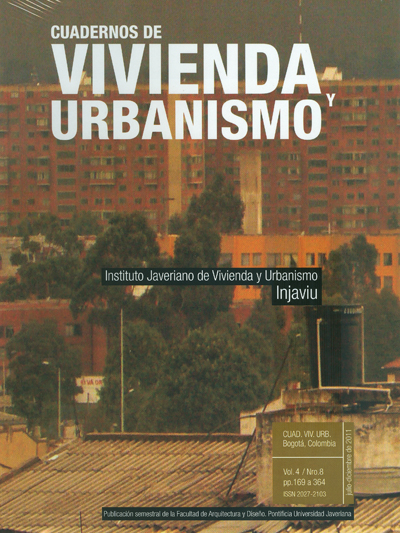Resumen
El cambio climático generado por la expansión del área urbana incide en el aumento de temperatura por las propiedades térmicas de los materiales de construcción. La escasez de áreas verdes (que aumenta las superficies impermeables) provoca desequilibrios climáticos que deterioran la calidad habitacional en el interior de la vivienda. En este sentido, este artículo se propone estimar y comparar la atenuación térmica y la captura de CO2 en viviendas de interés prioritario ubicadas en Altos de Cazucá, que utilizaron cultivos de hortalizas como ecotechos. El diseño experimental requirió desarrollos tecnológicos como un sistema de riego que optimiza el agua de precipitación y contenedores independientes para el sustrato y las plantas. Los cultivos están divididos en: 1) lechuga y rábano; 2) cebolla larga, cilantro y lechuga, y 3) espinaca y perejil. Se estudió también una vivienda testigo sin ecotecho. Luego, se cuantificaron las variables térmicas dentro de la vivienda y el carbono capturado. Los resultados son una atenuación térmica del techo (4 °C) y del ambiente (3 °C), un aumento de la humedad relativa del 10% y un total de CO2 capturado de 16,1 kg, 38,6 kg y 8,3 kg, anualmente.
Esta revista científica se encuentra registrada bajo la licencia Creative Commons Reconocimiento 4.0 Internacional. Por lo tanto, esta obra se puede reproducir, distribuir y comunicar públicamente en formato digital, siempre que se reconozca el nombre de los autores y a la Pontificia Universidad Javeriana. Se permite citar, adaptar, transformar, autoarchivar, republicar y crear a partir del material, para cualquier finalidad (incluso comercial), siempre que se reconozca adecuadamente la autoría, se proporcione un enlace a la obra original y se indique si se han realizado cambios. La Pontificia Universidad Javeriana no retiene los derechos sobre las obras publicadas y los contenidos son responsabilidad exclusiva de los autores, quienes conservan sus derechos morales, intelectuales, de privacidad y publicidad.
El aval sobre la intervención de la obra (revisión, corrección de estilo, traducción, diagramación) y su posterior divulgación se otorga mediante una licencia de uso y no a través de una cesión de derechos, lo que representa que la revista y la Pontificia Universidad Javeriana se eximen de cualquier responsabilidad que se pueda derivar de una mala práctica ética por parte de los autores. En consecuencia de la protección brindada por la licencia de uso, la revista no se encuentra en la obligación de publicar retractaciones o modificar la información ya publicada, a no ser que la errata surja del proceso de gestión editorial. La publicación de contenidos en esta revista no representa regalías para los contribuyentes.


